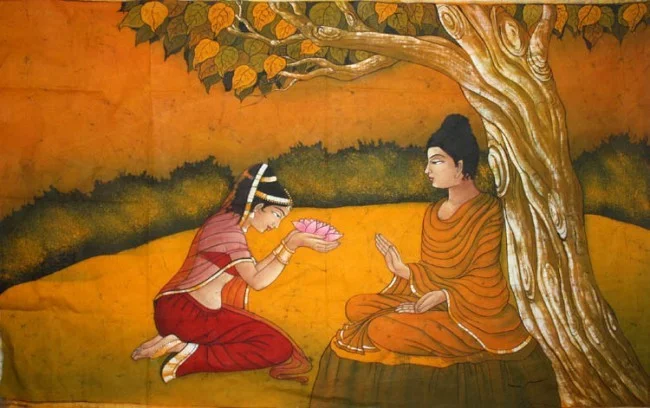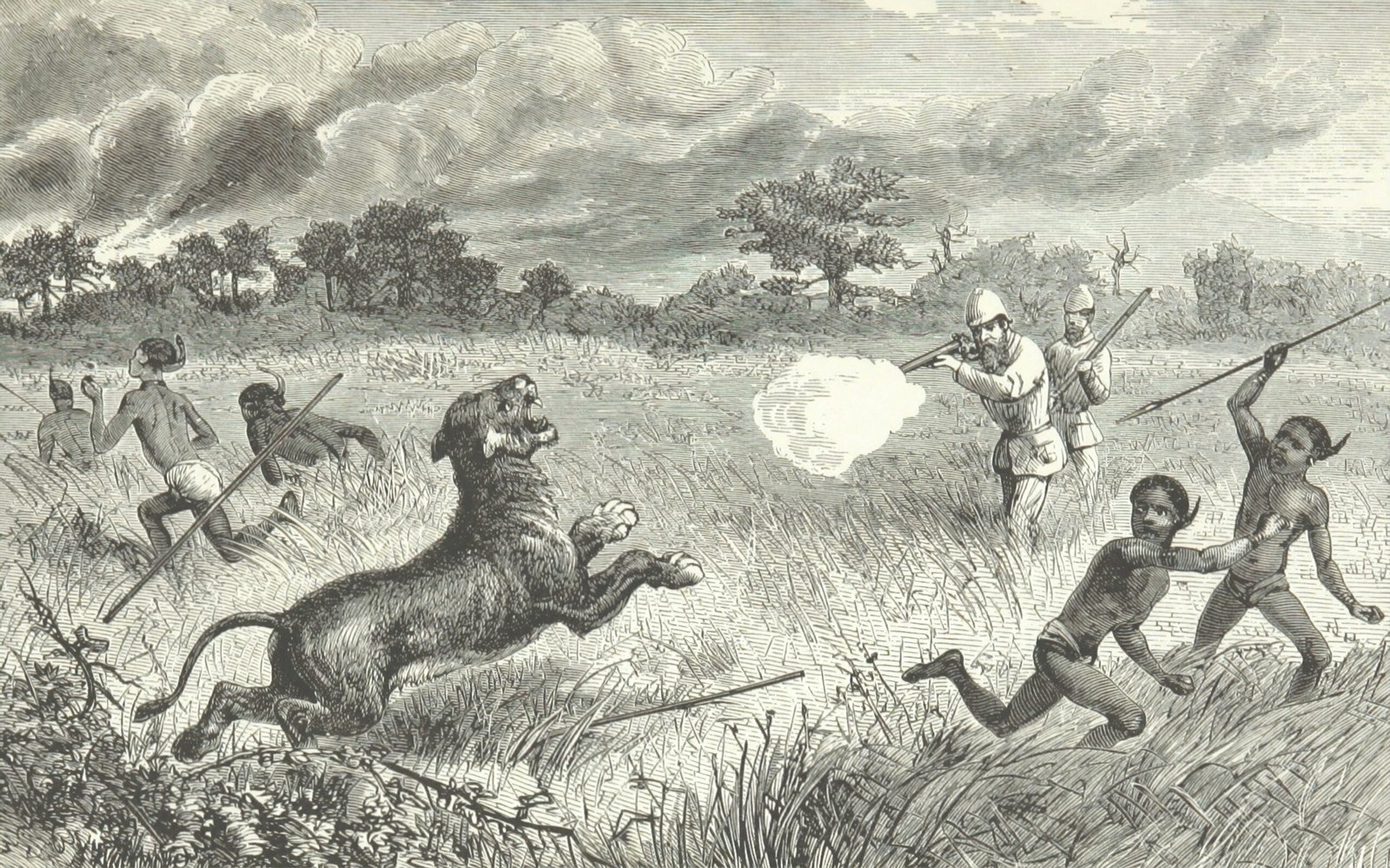Amrapali, also known as “Ambaplika,” “Ambapali,” or “Amra,” was a renowned royal courtesan of the republic of Vaishali in ancient India in approximately 500 BC. Vaishali was situated in modern-day Bihar. She became an arahant through practicing the Buddha’s teachings. She is referred to in ancient Pali texts and Buddhist traditions gama sutras, especially in relation to the Buddha staying at her mango grove, Ambapali vana, which she eventually bequeathed to his order and where he delivered the renowned Ambapalika Sutra. Around 1500 years ago, the Buddhist Jataka Tales, where Amrapali’s narrative first appeared.
She was known for her beauty, intelligence, and skill in various arts, such as dancing, music, and poetry.
According to legends, Amrapali was born from a mango tree and was later found by a group of royal courtiers who raised her as their own daughter. As she grew up, her extraordinary beauty and talents caught the attention of King Bimbisara of Magadha, who invited her to perform in his court. She soon became famous as the most beautiful and accomplished courtesan in the land.
Amrapali’s life took an unexpected turn when she met the Buddha, who visited Vaishali during his travels. She was deeply moved by his teachings and became his follower, eventually renouncing her former life and becoming a Buddhist nun. Her story has since become a symbol of the transformative power of spiritual awakening and the possibility of redemption for even the most worldly and indulgent individuals.
The Early Life of Amrapali: Legend and History
Amrapali was born to Mahanama and an unidentified mother between 600 and 500 BCE. Her name’s variations come from the combination of the Sanskrit words amra, which means mango, and pallawa, which means fresh leaves or sprouts. She is supposed to have been born at the base of a mango tree in one of Vaishali’s royal gardens, giving rise to her name.
Amrapali was unusually lovely and ethereal even as a little girl. According to legend, a feudal ruler by the name of Mahanaman was so seduced by the beauty of the young Amrapali that he left his realm and relocated to Ambara village, a small hamlet in Vaishali that is now in Muzaffarpur.
The Licchavi tribe, one of the eight Khattiya (Sanskrit Kshatriya) tribes that had joined together to form the Vajjian confederacy, had Vaishali as its capital city. An electoral college made up of princes and nobility from the Kshatriya clans chose the king. It was normal for the most stunning women in the country to dedicate themselves to the pleasure of many men rather than marrying one.
Amrapali developed into a lady of exceptional grace and charm who was skilled in a variety of artistic mediums. Amrapali was dancing in the city when Manudev, the king of Vaishali, noticed her and devised a plan to “own” her. On the day of their wedding, he killed Amrapali’s childhood sweetheart and prospective husband, Pushpakumar, and then issued a public statement announcing Amrapali as the “wife” of Vaishali, or the Nagarvadhu.
Also, she received the Vaishali Janpad Kalayani title, which was granted to the kingdom’s most attractive and talented female for seven years. Although Amrapali had the freedom to pick her lovers, the aforementioned norm prohibited her from committing to a single guy.
Amrapali was made a Nagarvadhu and afterward elevated to the rank of Rajanartiki, or court dancer. Amrapali’s brilliance and beauty drew in so many men that Vaishali’s glory during this time is frequently credited to her notoriety. Amrapali’s treasure grew significantly larger than the treasuries of certain kings, and admission to her performance cost fifty Karshapanas per night.
Amrapali and the Kings: Her Role in Politics and Diplomacy
The ruler of the rival neighboring country of Magadha, Bimbisara, heard tales of her beauty. After attacking Vaishali, he fled to Amrapali’s home. Bimbisara played music well. Amrapali and Bimbisara soon started dating.
When Amrapali discovered his true identity, she commanded Bimbisara to depart and end his conflict. Bimbisara, who was in love, complied with her request. He was viewed as a coward by the residents of Vaishali as a result of this incident. He later had a son named Vimala Kondanna through Amrapali.
Due to a conflict with his brothers, Ajatashatru, Bimbisara’s son via Queen Chellana, subsequently attacked Vaishali. When Amrapali was locked up, he destroyed the entire Vaishali because he was so affected by her beauty. Only his beloved Amrapali survived the massacre; however, when she witnessed the state of her motherland, she lost her love for him.
Meeting the Buddha: Amrapali’s Spiritual Transformation
According to Buddhist accounts, Amrapali had the chance to feed the Buddha during his final visit to Vaishali, just before he passed away. Amrapali heard him preach in a nearby grove, and she was so moved by it that she extended an invitation for dinner at her home.
Some traditions claim that the Buddha himself sought refuge in her mango gardens and was visited by Amrapali, who first offered him an invitation after making reverence to him. He gave his silent approval to her request.
The Vaishali royal lords were returning from inviting the Buddha to join them for dinner when their chariots clashed. They reprimand her, calling her a “mango-woman,” and ask the disreputable woman to move aside so that her superiors can pass. She then makes the announcement that the Buddha would be having dinner at her home. The princes were furious and made her a monetary offer in exchange for the right to welcome the Buddha, but she declines. Buddha declines them as well because he has already made a commitment to Amrapali.
Buddha noted her attractiveness and warned his followers to practice mindfulness around her lest they fall in love with her. Amrapali welcomed the Buddha and her entourage to her opulent home, which had been decorated especially for the event. Given the wealth she commanded, it was no less than the palace of any king.
After the supper, she gave the Buddha and his followers her entire estate, including the groves where she had held several discourses on mindfulness. She soon gave up her role as a courtesan, embraced Buddhism, and continued to actively serve the Buddhist order. She devoted her entire life to helping the underprivileged and the homeless. Vimala Kondanna, Amrapali’s son, grew up to become a Buddhist monk.
The Controversies and Debates Surrounding Amrapali’s Story
The Amrapali tale is important for comprehending courtesan attitudes in the present. Even though she achieved great fame as a gifted artist, the royal princes of Vaishali berated her by referring to her as a “ganika,” which had negative overtones. Buddha, in contrast to them, did not harbor any animosity toward her. He dined at her house and agreed to use her forest as a Buddhist temple. This is frequently used as an illustration of his impartial treatment of women.
Moreover, Amrapali’s potential partnership with Bimbisara has only been preserved orally and has not been included in the Pali canon of Buddhism. This is due to the fact that Bimbisara was a famous royal Buddhist patron, and his connections to Amrapali may reflect poorly on him. The canonical reference of Amrapali also places a lot of emphasis on the last years of her life, when she became a Buddhist.
Amrapali’s early life and her relationship with Bimbisara, however, are mentioned in chronicles of Chinese visitors who traveled to India in pursuit of Buddhist texts. The Chinese Recension of the Buddhist Tripitaka contains the latter. Since that this story was composed in the Mahayana tradition, it was not necessary to portray Bimbisara favorably. Their relationship is accentuated as a result.
The Forgotten Heroine of Ancient India
Amrapali, whose beauty had created and torn apart entire kingdoms, was allegedly born 2,500 years ago in a mango orchard in Vaishali. When Amrapali was a little girl, a nobleman by the name of Mahanaman from Vaishali, now a district on the banks of the River Ganga, had seen her exceptional beauty. Mahanaman left his kingdom and relocated to Ambara village, a small hamlet in Vaishali, allured by the beauty of Amrapali.
According to historians, Amrapali was named the “most beautiful” girl when she was 11 years old and went on to be named nagarvadhu and Vaishali Janpad Kalayani. According to the laws of Vaishali democracy, Amrapali quickly assumed the role of court dancer after receiving the title of nagarvadhu.
Lord Buddha, as well as the renowned Chinese travelers Fahayana and Huen Sang, have observed Amrapali’s magnetic beauty and aesthetic sense.






Amrapali: The Enchanting Courtesan Who Became a Buddhist Saint
Amrapali, also known as “Ambaplika,” “Ambapali,” or “Amra,” was a renowned royal courtesan of the republic of Vaishali in ancient India in approximately 500 BC. Vaishali was situated in modern-day Bihar. She became an arahant through practicing the Buddha’s teachings. She is referred to in ancient Pali texts and Buddhist traditions gama sutras, especially in […]